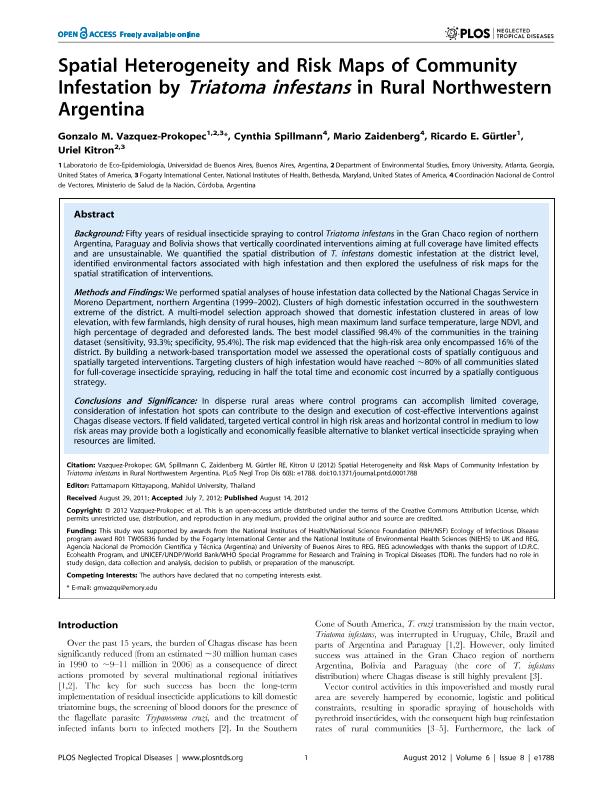Mostrar el registro sencillo del ítem
dc.contributor.author
Vazquez Prokopec, Gonzalo Martin

dc.contributor.author
Spillmann, Cynthia

dc.contributor.author
Zaidenberg, Mario
dc.contributor.author
Gurtler, Ricardo Esteban

dc.contributor.author
Kitron, Uriel
dc.date.available
2019-01-25T17:46:08Z
dc.date.issued
2012-08
dc.identifier.citation
Vazquez Prokopec, Gonzalo Martin; Spillmann, Cynthia; Zaidenberg, Mario; Gurtler, Ricardo Esteban; Kitron, Uriel; Spatial Heterogeneity and Risk Maps of Community Infestation by Triatoma infestans in Rural Northwestern Argentina; Public Library of Science; Neglected Tropical Diseases; 6; 8; 8-2012; 1-13; e1788
dc.identifier.issn
1935-2735
dc.identifier.uri
http://hdl.handle.net/11336/68634
dc.description.abstract
Background: Fifty years of residual insecticide spraying to control Triatoma infestans in the Gran Chaco region of northern Argentina, Paraguay and Bolivia shows that vertically coordinated interventions aiming at full coverage have limited effects and are unsustainable. We quantified the spatial distribution of T. infestans domestic infestation at the district level, identified environmental factors associated with high infestation and then explored the usefulness of risk maps for the spatial stratification of interventions. Methods and Findings: We performed spatial analyses of house infestation data collected by the National Chagas Service in Moreno Department, northern Argentina (1999-2002). Clusters of high domestic infestation occurred in the southwestern extreme of the district. A multi-model selection approach showed that domestic infestation clustered in areas of low elevation, with few farmlands, high density of rural houses, high mean maximum land surface temperature, large NDVI, and high percentage of degraded and deforested lands. The best model classified 98.4% of the communities in the training dataset (sensitivity, 93.3%; specificity, 95.4%). The risk map evidenced that the high-risk area only encompassed 16% of the district. By building a network-based transportation model we assessed the operational costs of spatially contiguous and spatially targeted interventions. Targeting clusters of high infestation would have reached ~80% of all communities slated for full-coverage insecticide spraying, reducing in half the total time and economic cost incurred by a spatially contiguous strategy. Conclusions and Significance: In disperse rural areas where control programs can accomplish limited coverage, consideration of infestation hot spots can contribute to the design and execution of cost-effective interventions against Chagas disease vectors. If field validated, targeted vertical control in high risk areas and horizontal control in medium to low risk areas may provide both a logistically and economically feasible alternative to blanket vertical insecticide spraying when resources are limited.
dc.format
application/pdf
dc.language.iso
eng
dc.publisher
Public Library of Science

dc.rights
info:eu-repo/semantics/openAccess
dc.rights.uri
https://creativecommons.org/licenses/by-nc-sa/2.5/ar/
dc.subject
Triatoma Infestans
dc.subject
Risk Map
dc.subject
Heterogeneity
dc.subject
Vector Control
dc.subject.classification
Otras Ciencias Biológicas

dc.subject.classification
Ciencias Biológicas

dc.subject.classification
CIENCIAS NATURALES Y EXACTAS

dc.title
Spatial Heterogeneity and Risk Maps of Community Infestation by Triatoma infestans in Rural Northwestern Argentina
dc.type
info:eu-repo/semantics/article
dc.type
info:ar-repo/semantics/artículo
dc.type
info:eu-repo/semantics/publishedVersion
dc.date.updated
2019-01-25T13:38:02Z
dc.journal.volume
6
dc.journal.number
8
dc.journal.pagination
1-13; e1788
dc.journal.pais
Estados Unidos

dc.journal.ciudad
San Francisco
dc.description.fil
Fil: Vazquez Prokopec, Gonzalo Martin. Universidad de Buenos Aires. Facultad de Ciencias Exactas y Naturales; Argentina. University of Emory; Estados Unidos. Fogarty International Center; Estados Unidos. Consejo Nacional de Investigaciones Científicas y Técnicas; Argentina
dc.description.fil
Fil: Spillmann, Cynthia. Ministerio de Salud. Coordinación Nacional de Control de Vectores; Argentina
dc.description.fil
Fil: Zaidenberg, Mario. Ministerio de Salud. Coordinación Nacional de Control de Vectores; Argentina
dc.description.fil
Fil: Gurtler, Ricardo Esteban. Universidad de Buenos Aires. Facultad de Ciencias Exactas y Naturales; Argentina. Consejo Nacional de Investigaciones Científicas y Técnicas; Argentina
dc.description.fil
Fil: Kitron, Uriel. University of Emory; Estados Unidos. Fogarty International Center; Estados Unidos
dc.journal.title
Neglected Tropical Diseases

dc.relation.alternativeid
info:eu-repo/semantics/altIdentifier/doi/http://dx.doi.org/10.1371/journal.pntd.0001788
dc.relation.alternativeid
info:eu-repo/semantics/altIdentifier/url/https://journals.plos.org/plosntds/article?id=10.1371/journal.pntd.0001788
Archivos asociados
